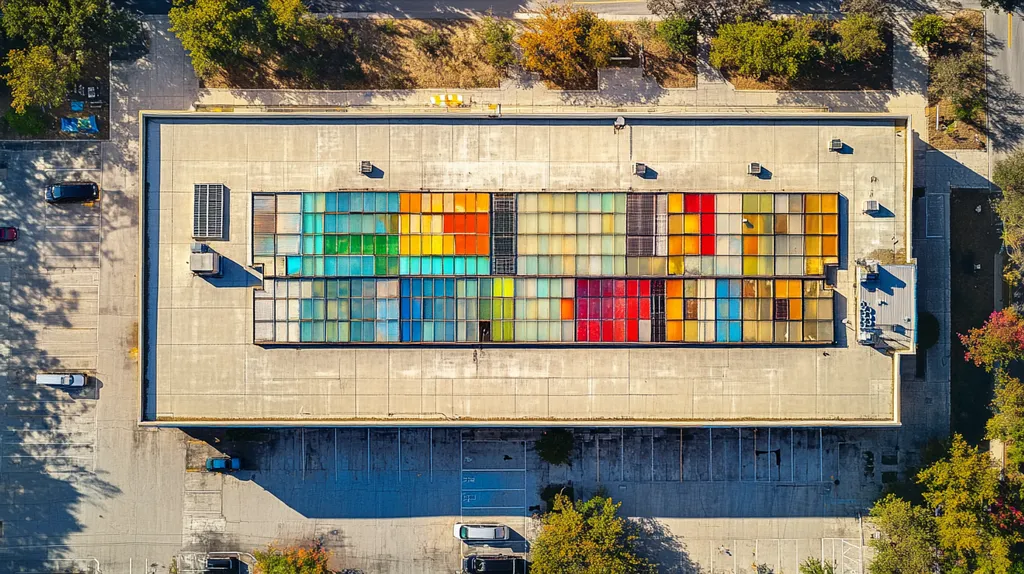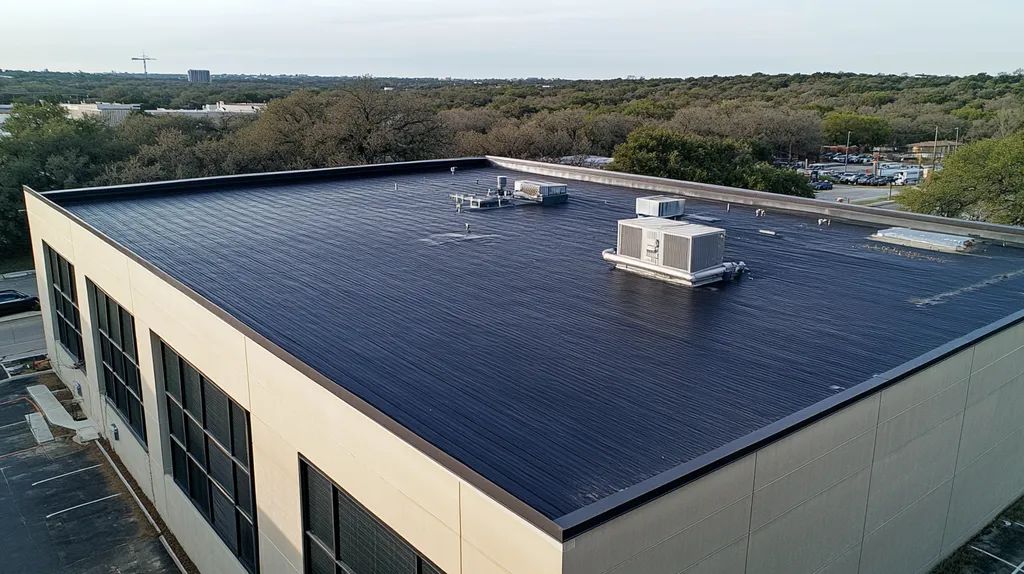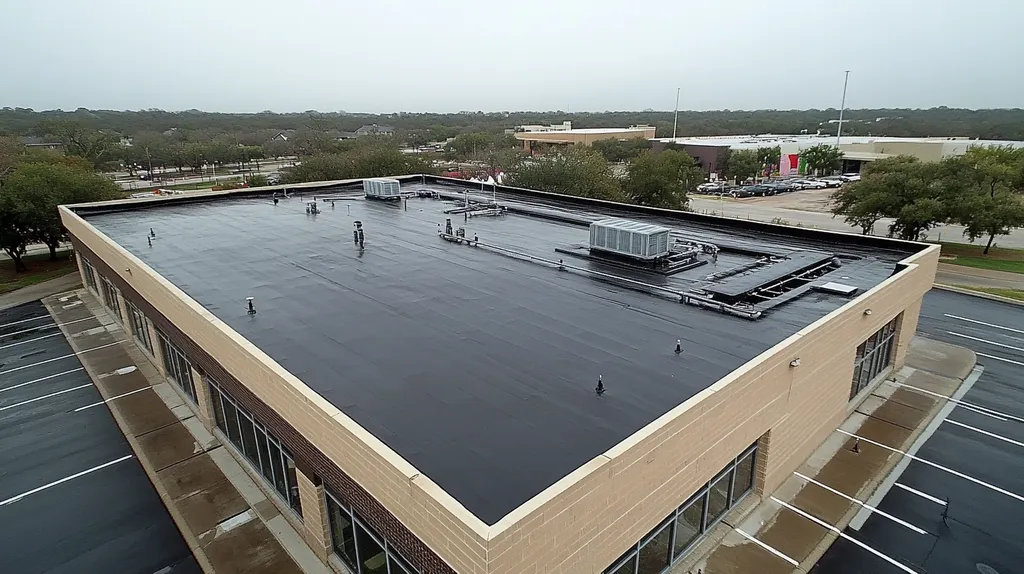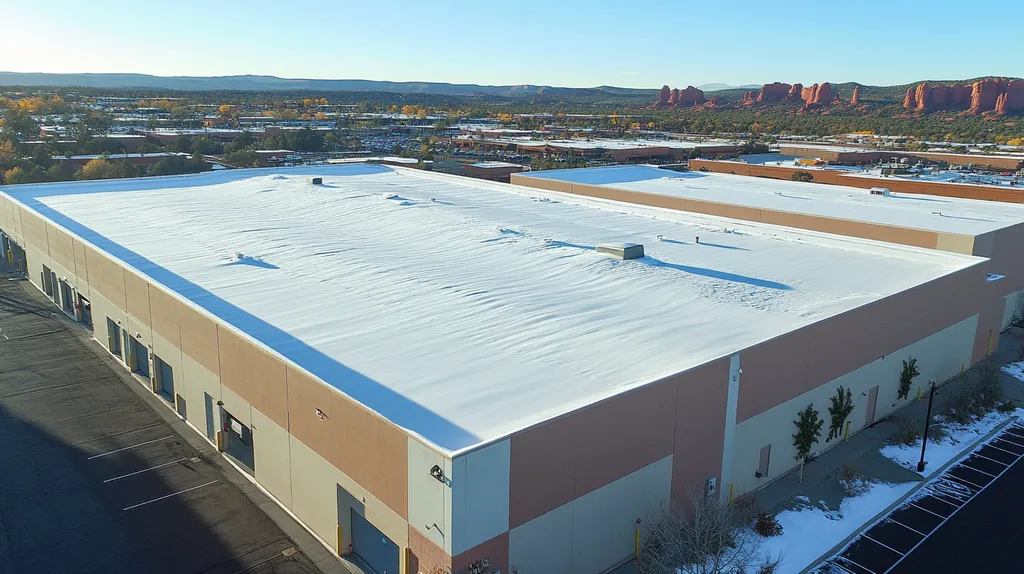Each year, over 11 million tons of commercial roofing materials end up in U.S. landfills, representing a massive environmental and financial burden for facility managers.
With landfill costs rising 5-7% annually and stricter environmental regulations emerging, recycling old roofing materials has become both an urgent necessity and strategic opportunity.
This comprehensive guide examines the key factors facility managers must consider when recycling roof materials: performance capabilities, financial implications, compliance requirements, risk management protocols, operational procedures, and long-term planning considerations.
SECTION 1: PERFORMANCE FACTORS
Recycling old commercial roof materials is not only a wise choice for the environment but also an urgent requirement. The U.S. generates approximately 11 million tons of roofing waste annually, with a significant portion ending up in landfills. Facility managers must prioritize assessing the durability and recyclability of roofing materials, identify contaminants, and select the right removal techniques to adopt a truly sustainable strategy.
Assessing Roof Material Durability for Recycling
Durability plays a pivotal role in determining which roofing materials are suitable for recycling. Materials like TPO (Thermoplastic Olefin) and EPDM (Ethylene Propylene Diene Monomer) typically outperform traditional built-up tar roofs in terms of recyclability. Gaining insights into the lifespan and stability of these materials helps facility managers identify candidates for repurposing.
Working closely with manufacturers and contractors to acquire detailed specifications on material durability is essential. If a roof is approaching the end of its life cycle and exhibits significant wear, options for recycling may be constrained. A thorough assessment enables facility managers to spot cost-effective recycling opportunities.
Additionally, the local recycling infrastructure should be considered. Facilities must research what roofing materials are accepted at nearby recycling centers to inform their investment choices. Selecting roofing types that are both recyclable and environmentally friendly can make a substantial difference.
Key Action Items
Identifying Contaminants and Mixed Material Challenges
Identifying contaminants is critical before recycling old roofing materials, as they can severely complicate the process. Common contaminants include adhesives, coatings, and difficult-to-separate materials like asphalt and metal. These elements can pose significant challenges to successful recycling efforts.
Mixed-material roofs bring an additional layer of complexity. Roofs with a combination of gravel, rubber, and metal may require different recycling methods, making processing cumbersome. For facility managers, understanding the roof’s composition is key to maximizing recyclability.
Conducting an assessment during removal can help mitigate these challenges. Documenting materials and conditions affecting recycling enables better planning. Collaborating with recycling experts during this phase is instrumental in effectively identifying and isolating recyclable materials.
Key Action Items
Evaluating Roof Removal Techniques to Preserve Recyclability
The roofing removal method chosen can greatly influence recyclability outcomes. Conventional removal techniques often entail rapid tearing off, which can compromise recyclable components. Employing careful disassembly strategies helps maintain material integrity, boosting their recycling potential.
Implementing techniques such as mechanical separation can yield better results since it allows for the preservation of different material types without damaging them. For example, using cranes for lifting roof sections can significantly reduce breakage and wear on materials.
Additionally, considering timing and weather conditions can enhance the effectiveness of roof removal. Planning to remove roofs on dry days minimizes complications from moisture, thereby improving the quality of recyclable materials.
Key Action Items
SECTION 2: FINANCIAL CONSIDERATIONS
Facility managers today face the dual challenge of managing budgets while meeting sustainability targets. Recycling commercial roof materials is not just an eco-friendly choice—it’s also a financially savvy one. A study by the National Roofing Contractors Association indicates that as much as 50% of roofing materials can be recycled, which can dramatically lower disposal costs. Grasping the financial aspects of roof recycling can empower property owners to make informed decisions.
Cost-Benefit Analysis of Recycling Versus Landfill Disposal
Understanding the financial benefits of recycling roofing materials compared to landfill disposal is crucial. Facility managers should perform a detailed cost-benefit analysis to compare the expenses related to both options. Depending on local regulations and market conditions, landfill fees can range from hundreds to thousands of dollars for a single job.
On the other hand, many recycling centers offer lower fees or even incentives, creating a financially advantageous alternative. By choosing to recycle, organizations not only lessen their landfill footprint but can also earn money from scrap materials—like aluminum and copper from roofs—offsetting disposal costs.
A careful evaluation of these costs often shows that recycling not only saves money but also supports better financial health for organizations.
Quantifying Savings from Reduced Hauling and Tipping Fees
Hauling and tipping fees can quickly accumulate, particularly for larger roofing projects. Adopting a recycling program can lead to immediate reductions in these expenses, translating into substantial cost savings. By opting for recycling, companies can decrease the number of trips needed to transport materials to landfills.
For example, a facility management company that processes around 30 tons of roofing waste could save up to 20% in hauling fees through recycling efforts. This reduction not only eases budget strains but also streamlines operations during roof replacements.
By quantifying these savings, facility managers can effectively communicate the financial advantages of recycling to stakeholders, showcasing its positive impact on the overall budget and sustainability initiatives.
Incentives and Funding Programs Supporting Roof Recycling
Numerous incentives and funding programs exist to promote roof recycling efforts. Many local and state governments offer grants or tax credits tailored for businesses engaged in sustainable practices, including the recycling of old roofing materials. This financial support can significantly ease the initial costs tied to implementing recycling programs.
Additionally, organizations such as the Environmental Protection Agency (EPA) provide valuable resources and listings of available programs that facility managers can utilize. Engaging with these programs can further lessen the overall expenses of a roofing project.
By actively seeking out these incentives, property owners can improve their financial position while also committing to environmentally responsible practices, demonstrating their dedication to sustainability.
SECTION 3: COMPLIANCE REQUIREMENTS
Adhering to compliance requirements for recycling old commercial roof materials is crucial for facility managers. Non-compliance can incur substantial fines and damage a facility’s reputation. Furthermore, misunderstanding these regulations can lead to environmental harm, negatively affecting local communities. In this section, we will explore critical federal and state regulations, address risks associated with hazardous materials like asbestos, and outline necessary documentation and reporting obligations.
Understanding Federal and State Environmental Regulations
Compliance begins with a clear understanding of the federal and state regulations that govern roofing waste management. The Environmental Protection Agency (EPA) imposes rigorous standards related to waste management, especially for roofing materials. For example, asphalt shingles must be disposed of in accordance with the Resource Conservation and Recovery Act (RCRA).
Each state may also enforce additional regulations that could be stricter than federal standards. Non-compliance with these regulations can result in financial penalties and complexities for future roofing projects. Facility managers are advised to consult their state’s environmental agency to ensure complete compliance.
Additionally, some local municipalities might enforce specific recycling goals or mandates. Awareness of these guidelines aids compliance and enhances a facility’s sustainability profile, potentially attracting environmentally conscious tenants. Establishing a recycling plan that aligns with these regulations not only demonstrates responsible facility management but also contributes to community health.
Key Action Items
Managing Asbestos and Hazardous Material Risks
Asbestos remains a significant concern in many older roofing materials. Facility managers must take strict precautions if roofing materials may contain asbestos. The use of asbestos is heavily regulated under the Clean Air Act, requiring proper handling and disposal procedures.
Before commencing any recycling project, a thorough assessment of roofing materials is essential. Engaging professionals trained in hazardous material management is vital to ensure compliance and ensure safety for all involved.
Improper handling of asbestos can pose serious health risks to workers and nearby communities, resulting in liability for the facility. Therefore, thorough documentation of each step of the process, including material testing and disposal methods, is crucial in mitigating these risks.
Key Action Items
Documentation and Reporting Obligations for Recycling Programs
Effective documentation is essential when implementing a roofing materials recycling program. Facility managers must maintain accurate records of recycled materials, disposal methods, and compliance with local regulations. Such documentation not only proves compliance but serves as a roadmap for best practices.
Depending on the volume and type of materials recycled, regular reporting to state agencies may be required. These reports often necessitate detailed information regarding the origin of materials, processing methods, and final destinations. Keeping organized records will streamline inspections and audits.
Additionally, communication with contractors and waste management teams is key for ensuring seamless operations. Clear guidelines should be established to delineate roles and responsibilities effectively.
Key Action Items
SECTION 4: RISK MANAGEMENT
Effectively managing the recycling of old commercial roofing materials involves navigating a complex landscape of risks. Improper handling can lead to serious legal liabilities and health concerns. The Environmental Protection Agency indicates that over 10 million tons of roofing waste are discarded in landfills each year, underscoring the need for vigilant management. This section focuses on liability issues in waste handling, health risks during the recycling process, and the necessity of qualified contractors.
Addressing Liability in Handling and Transporting Roof Waste
Liability in roofing waste management cannot be overstated. Accidental spills or improper transportation of roofing materials can create not only environmental hazards but also considerable legal risks for property owners.
Contractors are required to adhere to local and federal regulations for waste disposal and recycling. Non-compliance can result in hefty fines, legal repercussions, and damage to a facility’s public image.
Choosing certified waste management companies is essential to ensure that materials are processed correctly. Facility managers should always request and maintain documentation for compliance to safeguard against potential liabilities.
Key Action Items
Mitigating Health Risks During Tear-Off and Recycling Processes
The roofing tear-off process can expose workers to significant health risks, such as inhalation of harmful dust and materials. Ensuring worker safety must be a top priority during both removal and recycling operations.
Establishing robust safety protocols is crucial. This should include providing personal protective equipment (PPE) and offering regular training on safe practices for handling materials.
Facility managers should ensure that all personnel involved are educated on identifying and mitigating potential hazards. Utilizing effective ventilation systems can also significantly reduce airborne contaminants during the process.
Key Action Items
Ensuring Contractor Qualifications and Certification Standards
Selecting qualified contractors is vital for the successful recycling of roofing materials. Not every contractor has the necessary expertise for managing materials safely and efficiently.
Facility managers should prioritize hiring contractors who hold certifications from recognized industry organizations. Certification is an indicator of compliance with industry standards and reliance on best practices.
Conducting thorough evaluations of contractors, including background checks and assessments of past projects, can provide valuable insights into their capabilities. Open communication and clear expectations are essential for maintaining accountability and fostering effective partnerships.
Key Action Items
SECTION 5: OPERATIONAL PROCEDURES
Implementing effective recycling procedures for old commercial roof materials is critical for maximizing sustainability efforts. As the roofing industry contributes around 11 million tons of waste annually, improper handling can lead to unnecessary landfill contributions. Establishing robust operational protocols not only optimizes recycling practices but also aligns with the growing demand for environmentally responsible actions.
Best Practices for Roof Material Separation and Sorting
A systematic approach to material separation is essential for recycling success. Facility managers should create a sorting plan that clearly categorizes different materials such as asphalt shingles, metals, and insulation to enhance overall efficiency.
Utilizing color-coded bins for various material types can significantly simplify the sorting process for workers. These visual tools minimize contamination by preventing recyclable materials from being mixed with non-recyclables.
It’s also vital to provide regular training sessions to staff on the importance of proper separation. Ongoing workshops reinforce best practices and keep recycling at the forefront of team members’ priorities.
Conducting regular audits of sorting practices can help identify potential improvements. Monitoring waste output allows facility managers to optimize their strategies, further increasing recycling efficacy.
Key Action Items
Coordinating Logistics for Collection and Transport to Recycling Facilities
Efficient logistics are pivotal for transporting sorted materials to recycling centers. Establishing strong partnerships with local recycling facilities ensures that materials are handled correctly from the moment they leave the job site.
Facility managers should plan for regular material pickups to prevent accumulation and maintain workflow efficiency. Scheduling these interactions with recycling centers helps reduce hauling costs and enhances overall operational effectiveness.
Choosing appropriate transportation suited for specific materials is also key. For instance, using flatbed trucks can facilitate the transport of bulky materials, while enclosed vehicles protect delicate recyclables.
Organizing a centralized holding area for sorted materials can streamline logistics, minimizing transport time and improving overall operational efficiency.
Key Action Items
Tracking and Verifying Recycling Outcomes and Material Destinations
Monitoring recycling outcomes is crucial to ensure materials are processed as planned. Facility managers should adopt a tracking system that captures every step in the recycling lifecycle, from collection to final destination.
Verification entails retaining documentation from recycling facilities detailing the types and volumes of materials processed. This not only validates compliance with sustainability goals but also provides data for assessing recycling performance.
Soliciting feedback from recycling partners can further refine tracking processes. Understanding the challenges faced can help facility managers adapt and improve their procedures effectively.
Finally, showcasing recycling successes can bolster the organization’s commitment to sustainability and inspire active participation from all staff. Clear performance metrics establish a culture of accountability and pride in responsible practices.
Key Action Items
SECTION 5: OPERATIONAL PROCEDURES
Implementing systematic operational procedures for recycling old commercial roof materials is vital for enhancing sustainability efforts. As facility managers grapple with increasing pressure to adopt environmentally friendly practices, improper separation and sorting can result in massive waste, with the roofing industry responsible for around 11 million tons annually. By establishing clear procedures, organizations can maximize recycling success while minimizing their ecological footprint.
Best Practices for Roof Material Separation and Sorting
Adopting best practices for roof material separation significantly boosts recycling effectiveness. Facility managers should devise a sorting strategy that categorizes materials like asphalt shingles, metal, and insulation to streamline the recycling process.
Utilizing color-coded bins for each material type simplifies the sorting task for workers. These visual cues greatly reduce contamination, ensuring recyclable materials are not mixed with those that cannot be recycled.
Training staff on the importance of proper material separation is crucial. Regular workshops reinforce these best practices, keeping recycling top-of-mind for all employees involved in roofing projects.
Conducting routine audits of sorting practices helps identify areas for improvement. By closely monitoring waste output, facility managers can continuously refine their strategies and enhance recycling performance.
Key Action Items
Coordinating Logistics for Collection and Transport to Recycling Facilities
Effective logistical coordination is critical for transporting sorted materials to recycling centers. Establishing partnerships with local recycling facilities can streamline the process and ensure proper material handling.
Facility managers should schedule regular pickups to prevent material accumulation. Coordinating these schedules with recycling centers enhances efficiency and cuts hauling costs.
Additionally, selecting appropriate transportation for different material types is essential. For example, flatbed trucks are ideal for bulky materials, while enclosed vehicles are better suited for protecting sensitive recyclables.
Creating a centralized holding area for sorted materials simplifies logistics by reducing transport time between collection points and recycling facilities, promoting overall operational efficiency.
Key Action Items
Tracking and Verifying Recycling Outcomes and Material Destinations
Monitoring recycling outcomes is essential to ensure materials are processed as intended. Facility managers should implement a tracking system that documents every step of the recycling lifecycle, from collection to final processing.
Verification requires maintaining records from recycling facilities detailing which materials were received and processed. This not only demonstrates compliance with sustainability goals but provides crucial data for evaluating recycling efforts’ effectiveness.
Encouraging feedback from recycling partners can enhance tracking processes. Understanding the challenges they face enables facility managers to make necessary adjustments and improve operations.
Lastly, publicizing recycling achievements can strengthen the commitment to sustainability and engage all staff members in these initiatives. Clear metrics of success foster a culture of accountability and pride in responsible practices.
Key Action Items
Moving Forward
With landfill costs rising 5-7% annually and over 11 million tons of commercial roofing waste generated each year, recycling old roof materials has become an economic and environmental imperative.
Successful recycling programs hinge on understanding material performance factors, financial implications, compliance requirements, and operational best practices outlined in this guide.
Facility managers who implement proper material separation, engage qualified contractors, and maintain thorough documentation can reduce disposal costs by up to 30% while meeting sustainability goals.
The roofing industry’s shift toward circular material use will only accelerate as regulations tighten and landfill fees increase, making now the critical time to establish robust recycling protocols.
Those who delay risk higher costs, compliance issues, and missed opportunities in an increasingly sustainability-focused market.
FREQUENTLY ASKED QUESTIONS
Q. How can I assess my commercial roof materials’ durability for recycling?
A. Evaluate the lifespan and stability of roofing materials like TPO and EPDM for recycling potential. Collaborate with manufacturers for specifications, and assess the roof’s condition to ensure proper recycling options.
Q. What financial benefits can recycling my commercial roof provide?
A. Recycling can significantly lower disposal costs and potentially earn revenue from scrap materials. A thorough cost-benefit analysis comparing recycling versus landfill disposal reveals financial advantages, including reduced hauling fees.
Q. What compliance requirements do I need to follow for commercial roof recycling?
A. Familiarize yourself with federal and state environmental regulations regarding roofing waste. Ensure compliance to avoid fines and establish a recycling plan that meets regulations and community guidelines.
Q. How can I manage risks when recycling old commercial roof materials?
A. Address liability issues by adhering to waste management regulations and using certified contractors. Implement safety measures to protect workers during material handling and recycling processes.
Q. What are the best practices for sorting commercial roof materials for recycling?
A. Develop a sorting strategy using color-coded bins for different materials. Regular training for staff on proper separation and conducting audits will enhance efficiency in the recycling process.
Q. How can I track the recycling outcomes of my commercial roof materials?
A. Implement a tracking system to document the recycling process, from collection to the final destination. Maintain records from recycling facilities and seek feedback from partners to refine practices.
Q. Are there specific programs to assist with commercial roof recycling efforts?
A. Yes, many local and state governments offer grants or tax credits for businesses engaging in sustainable practices, including roof recycling. Consult relevant agencies for potential funding opportunities.










